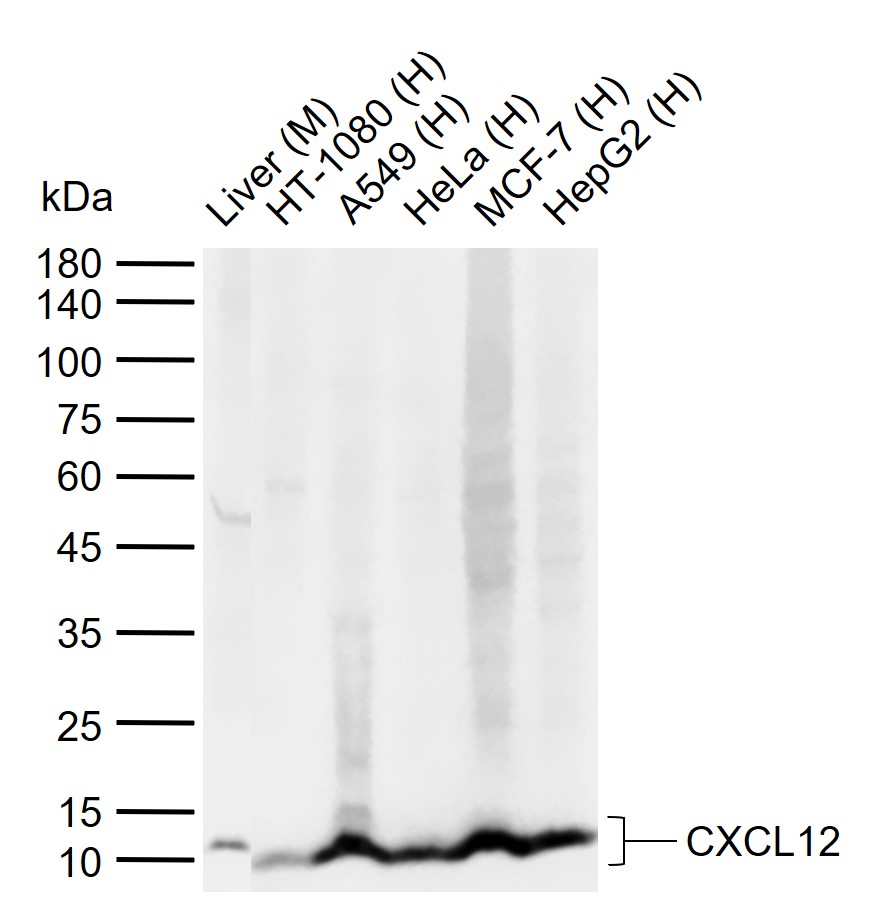
Rabbit Anti-CXCL12 antibody
SDF1 alpha; C-X-C motif chemokine 12; Chemokine (C X C motif) ligand 12; hIRH; hSDF-1; Intercrine reduced in hepatomas; IRH; PBSF; PBSF; Pre B cell growth stimulating factor; Pre-B cell growth-stimulating factor; SCYB12; SDF 1 alpha; SDF-1; SDF 1 beta; SD
View History [Clear]
Details
Product Name CXCL12 Chinese Name 基质细胞衍生因子1抗体 Alias SDF1 alpha; C-X-C motif chemokine 12; Chemokine (C X C motif) ligand 12; hIRH; hSDF-1; Intercrine reduced in hepatomas; IRH; PBSF; PBSF; Pre B cell growth stimulating factor; Pre-B cell growth-stimulating factor; SCYB12; SDF 1 alpha; SDF-1; SDF 1 beta; SDF 1b; SDF-1; SDF-1-alpha(3-67); SDF1; SDF1_HUMAN; SDF1a; SDF1b; Stromal cell derived factor 1; TLSF a; TLSF b; TLSFa; TLSFb; TPAR1. literatures Research Area Cell biology immunology Immunogen Species Rabbit Clonality Polyclonal React Species Human, Mouse, (predicted: Rat, Chicken, Dog, Pig, Guinea Pig, ) Applications WB=1:500-2000 ELISA=1:5000-10000 IHC-P=1:100-500 IHC-F=1:100-500 IF=1:50-200 (Paraffin sections need antigen repair)
not yet tested in other applications.
optimal dilutions/concentrations should be determined by the end user.Theoretical molecular weight 8kDa Cellular localization Secretory protein Form Liquid Concentration 1mg/ml immunogen KLH conjugated synthetic peptide derived from human SDF-1/CXCL12: 24-70/93 Lsotype IgG Purification affinity purified by Protein A Buffer Solution 0.01M TBS(pH7.4) with 1% BSA, 0.03% Proclin300 and 50% Glycerol. Storage Shipped at 4℃. Store at -20 °C for one year. Avoid repeated freeze/thaw cycles. Attention This product as supplied is intended for research use only, not for use in human, therapeutic or diagnostic applications. PubMed PubMed Product Detail This gene encodes a stromal cell-derived alpha chemokine member of the intercrine family. The encoded protein functions as the ligand for the G-protein coupled receptor, chemokine (C-X-C motif) receptor 4, and plays a role in many diverse cellular functions, including embryogenesis, immune surveillance, inflammation response, tissue homeostasis, and tumor growth and metastasis. Mutations in this gene are associated with resistance to human immunodeficiency virus type 1 infections. Multiple transcript variants encoding different isoforms have been found for this gene. [provided by RefSeq, May 2013].
Function:
Chemoattractant active on T-lymphocytes, monocytes, but not neutrophils. Activates the C-X-C chemokine receptor CXCR4 to induce a rapid and transient rise in the level of intracellular calcium ions and chemotaxis. Also binds to another C-X-C chemokine receptor CXCR7, which activates the beta-arrestin pathway and acts as a scavenger receptor for SDF-1. SDF-1-beta(3-72) and SDF-1-alpha(3-67) show a reduced chemotactic activity. Binding to cell surface proteoglycans seems to inhibit formation of SDF-1-alpha(3-67) and thus to preserve activity on local sites. Acts as a positive regulator of monocyte migration and a negative regulator of monocyte adhesion via the LYN kinase. Stimulates migration of monocytes and T-lymphocytes through its receptors, CXCR4 and CXCR7, and decreases monocyte adherence to surfaces coated with ICAM-1, a ligand for beta-2 integrins. SDF1A/CXCR4 signaling axis inhibits beta-2 integrin LFA-1 mediated adhesion of monocytes to ICAM-1 through LYN kinase. Inhibits CXCR4-mediated infection by T-cell line-adapted HIV-1. Plays a protective role after myocardial infarction. Induces down-regulation and internalization of CXCR7 expressed in various cells. Has several critical functions during embryonic development; required for B-cell lymphopoiesis, myelopoiesis in bone marrow and heart ventricular septum formation.
Subunit:
Monomer or homodimer; in equilibrium. Dimer formation is induced by non acidic pH and the presence of multivalent anions, and by binding to CXCR4 or heparin. Monomeric form is required for full chemotactic activity and resistance to ischemia/reperfusion injury, whereas the dimeric form acts as a partial agonist of CXCR4, stimulating Ca2+ mobilization but with no chemotactic activity and instead acts as a selective antagonist that blocks chemotaxis induced by the monomeric form. Interacts with the N-terminus of CXCR7.
Subcellular Location:
Secreted.
Tissue Specificity:
Isoform Alpha and isoform Beta are ubiquitously expressed, with highest levels detected in liver, pancreas and spleen. Isoform Gamma is mainly expressed in heart, with weak expression detected in several other tissues. Isoform Delta, isoform Epsilon and isoform Theta have highest expression levels in pancreas, with lower levels detected in heart, kidney, liver and spleen.
Post-translational modifications:
Processed forms SDF-1-beta(3-72) and SDF-1-alpha(3-67) are produced after secretion by proteolytic cleavage of isoforms Beta and Alpha, respectively. The N-terminal processing is probably achieved by DPP4. Isoform Alpha is first cleaved at the C-terminus to yield a SDF-1-alpha(1-67) intermediate before being processed at the N-terminus. The C-terminal processing of isoform Alpha is reduced by binding to heparin and, probably, cell surface proteoglycans.
Similarity:
Belongs to the intercrine alpha (chemokine CxC) family.
SWISS:
P48061
Gene ID:
6387
Database links:Entrez Gene: 6387 Human
Entrez Gene: 20315 Mouse
SwissProt: P48061 Human
SwissProt: P40224 Mouse
Omim: 600835 Human
Product Picture
Lane 1: Mouse Liver tissue lysates
Lane 2: Human HT-1080 tissue lysates
Lane3: Human A549 cell lysates
Lane4: Human HeLa cell lysates
Lane 5: Human MCF-7 cell lysates
Lane 6: Human HepG2 cell lysates
Primary: Anti- CXCL12 (SL4938R) at 1/1000 dilution
Secondary: IRDye800CW Goat Anti-Rabbit IgG at 1/20000 dilution
Predicted band size: 8 kDa
Observed band size: 10 kDa
References (0)
No References
Bought notes(bought amounts latest0)
No one bought this product
User Comment(Total0User Comment Num)
- No comment



 +86 571 56623320
+86 571 56623320
 +86 18668110335
+86 18668110335

